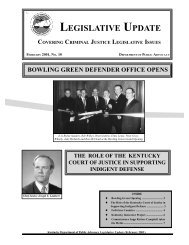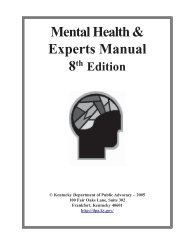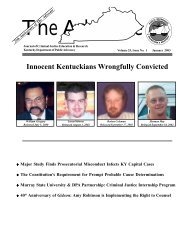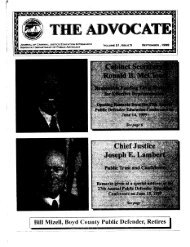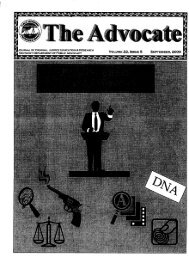May 2002 - Department of Public Advocacy
May 2002 - Department of Public Advocacy
May 2002 - Department of Public Advocacy
You also want an ePaper? Increase the reach of your titles
YUMPU automatically turns print PDFs into web optimized ePapers that Google loves.
Continued from page 29<br />
that evidence that Bray fled to Canada was admissible, but<br />
anything pertaining the television show should be kept out<br />
on re-trial.<br />
“Unlawful Flight To Avoid Prosecution”<br />
Warrant Inadmissible<br />
Bray argued that testimony that he had been charged with<br />
the collateral federal crime <strong>of</strong> unlawful flight to avoid prosecution<br />
should not have been admitted into evidence. The<br />
Commonwealth claimed that such testimony was allowed<br />
under Commonwealth v. Howard, Ky., 287 S.W.2d 926 (1955)<br />
as a “fact and circumstance” showing evasion and resisting<br />
arrest. The Court held that the fact that Bray had fled that<br />
country and had been captured through the coordination <strong>of</strong><br />
the United States and Canadian authorities was properly admitted.<br />
However, that Court found that the collateral criminal<br />
charge itself was not a “fact and circumstance” surrounding<br />
Bray’s fleeing the country and was highly prejudicial and<br />
irrelevant to the proceedings.<br />
Second-Degree Arson Instruction<br />
Should Have Been Given;<br />
No Directed Verdict On First-Degree Arson<br />
Bray argued that he was entitled to a second-degree arson<br />
instruction. Since the two victims were already dead from<br />
gunshot wounds before the home was set on fire, the jury<br />
could have believed that the house was not inhabited or<br />
occupied by living persons. The Commonwealth maintained<br />
that the first-degree arson statute is designed to cover the<br />
destruction <strong>of</strong> “dwellings,” while the second-degree arson<br />
statute is designed to cover other situations such as arson<br />
for pr<strong>of</strong>it. The Court held that the jury should have been<br />
instructed on second-degree arson, noting that the evidence<br />
in the case could have permitted the jury to conclude that the<br />
victims had been killed before the fire was started. However,<br />
since the evidence was inconclusive as to whether the victims<br />
were living or dead at the time the house was set afire,<br />
the Court held that the trial court did not err by failing to<br />
direct a verdict on first-degree arson.<br />
Statement Opened The Door To<br />
Questions About Prior Shooting Incident<br />
The Court also held that Candie Bray’s statement on crossexamination<br />
that Bray was afraid <strong>of</strong> Mary York because she<br />
was “out to get him” opened the door to further questioning<br />
regarding the meaning <strong>of</strong> her statement. Therefore, there<br />
was no error when the Commonwealth responded that it was<br />
Bray who assaulted Mary and continued to question Candie<br />
concerning the events <strong>of</strong> the assault which involved a “shooting<br />
incident” for which Bray was criminally charged.<br />
THE ADVOCATE Volume 24, No. 3 <strong>May</strong> <strong>2002</strong><br />
Bennie L. Gamble, Jr. v. Commonwealth,<br />
Ky., __ S.W.3d __ (02/21/02)<br />
(Reversing and remanding for a new trial)<br />
Gamble, Chasidy Bradley and Barbara Neill were arrested and<br />
indicted for the robbery and murder <strong>of</strong> William Tolbert. While<br />
Gamble maintained his innocence, Bradley and Neill gave<br />
statements about their involvement, as well as Gamble’s, in<br />
the crimes. Neill eventually pled guilty and testified against<br />
Bradley and Gamble in exchange for a 25-year prison sentence.<br />
Bradley and Gamble were tried together. Both were<br />
convicted <strong>of</strong> first-degree robbery and murder. Bradley received<br />
a 25-year sentence. Gamble was sentenced to life in<br />
prison. Gamble is African-American, while the victim was<br />
Caucasian, as are Bradley and Neill.<br />
Batson Objection Timely, But No Batson Violation Found<br />
The Commonwealth used its peremptory challenges to strike<br />
three <strong>of</strong> four African-American jurors from the venire. Gamble<br />
challenged the Commonwealth’s use <strong>of</strong> its strikes as racially<br />
motivated. The Court found Gamble’s Batson objection to<br />
be timely made where defense counsel raised the objection<br />
as soon as practicable after the 14 jurors names were called<br />
and before the jury was sworn. However, the Court found no<br />
Batson violation where the Commonwealth <strong>of</strong>fered the following<br />
grounds for its peremptory challenges: the prosecutor<br />
tried a murder case against a prospective juror’s son who<br />
was ultimately convicted <strong>of</strong> murder; a prospective juror’s<br />
brother had successfully sued and recovered a judgment<br />
against a police <strong>of</strong>ficer/department for false arrest; a prospective<br />
juror was approached by a witness in the case and<br />
had spoken about the case, and she had recently been<br />
stopped by the police and charged with a series <strong>of</strong> traffic<br />
<strong>of</strong>fenses. The Court noted that “[t]he trial court may accept<br />
at face value the explanation given by the prosecutor depending<br />
upon the demeanor and credibility <strong>of</strong> the prosecutor.”<br />
Stanford v. Commonwealth, Ky., 793 S.W.2d 112 (1980).<br />
Trial Court Erred In Refusing<br />
To Strike Juror With Racist Views<br />
On appeal, Gamble argued that the trial court erred in failing<br />
to exclude racist jurors for cause, compelling him to exercise<br />
his peremptory challenges on incompetent jurors. During<br />
voir dire, Juror #54 indicated that he had moved from his prior<br />
neighborhood because he had a young daughter and he<br />
“never felt safe” because there were “black guys” always<br />
around the house. He indicated strong opposition to interracial<br />
relationships, stating that he generally thought <strong>of</strong> people<br />
involved in such relationships as low class, and <strong>of</strong> low class<br />
people as more likely to commit crime. Juror #54 further stated<br />
that he could not deny his prejudices and that upon entering<br />
the courtroom he automatically assumed Gamble to be the<br />
defendant because he “figured a black had to be the person<br />
accused.” Despite having made these statements, when asked<br />
30



